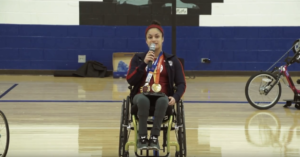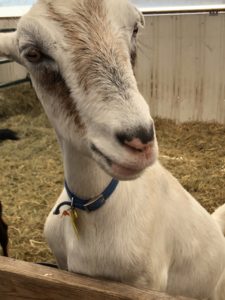Mondays with Mike: Be sure to vote today for the Seeing Eye by 11:59 ET
October 22, 2018 • 4 Comments • Posted in Beth Finke, blindness, guide dogs, Mike Knezovich, Mondays with Mike, Seeing Eye dogs, travelOne thing I never, ever, ever take for granted is how much each of Beth’s Seeing Eye dogs has meant to Beth and to us. I still remember the days when Beth struggled to hone her cane skills—it was a real struggle for both of us. I constantly worried, she didn’t get around as independently as she does now, which affected both of us and our relationship.
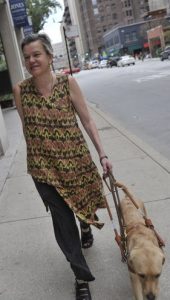
My gals get around, thanks to The Seeing Eye. (Photo: Bill Healy)
And, people treated her differently. I witnessed it and still do. People see Beth with Whitney and they, at the least, smile. And most don’t hesitate to strike up a conversation. When Beth used a cane, they got quiet and nervous and just cleared out of the way. Even when I accompany Beth, it’s different with the dog than with the cane. There’s a palpable nervousness when people see the cane. This is not to harp on them, and plenty of people with a visual impairment thrive without a dog.
But given Beth’s disposition and spirit, Pandora, Hanni, Harper, and now Whitney have been priceless additions to our family.
That’s all owed to The Seeing Eye, a non-profit organization based in Morristown, New Jersey. It was the first guide dog school in the United States, and Morris Frank—a co-founder—crusaded for the use of guide dogs and the right for people with guide dogs to access hotels, restaurants, trains, planes and other places otherwise closed to animals. (I can’t imagine what he’d think of the concept of emotional support peacocks, but that’s another topic.)
The Seeing Eye breeds dogs, matches them with puppy-raisers, then, through an intensive program, trainers spend four months teaching the dogs who make it that far to lead a person with a visual impairment. The dogs that make it through this part of the program are then matched with a human companion who has met the school’s admission requirements. Then, the two of them go through nearly four weeks of on regimented, on-campus training. (For a great look at the process, check out the documentary Pick of the Litter, which chronicles the journey of guide dog candidates. It’s filmed at Guide Dogs for the Blind, a terrific school on the West Coast—and the process at both schools is very similar. FYI, less than half the puppies end up making the cut.)
It’s a big deal, a ton of work, and really expensive. Roughly $50,000 per dog. The Seeing Eye charges students only $150 for their first dog and $50 for each thereafter. Veterans of the military pay $1. From the Seeing Eye web site:
A fraction of the total cost to create a match between person and dog, this fee reflects the student’s commitment to enhanced independence.
Right now, The Seeing Eye is participating in a contest whereby the highest vote getter among three non-profits will receive $50,000.
I hereby endorse The Seeing Eye, and urge you to vote for itat this link:
But do it fast. You have until 11:59 ET TONIGHT, October 22, 2018 to cast your vote for the Seeing Eye.


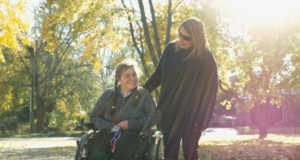
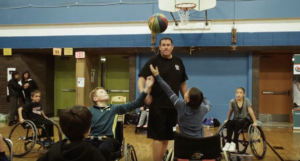 Schools are instrumental in breaking down barriers, fears and misunderstanding about disabilities. By celebrating and enlightening kids, school becomes the change agent the world needs to include and accept children with disabilities in every aspect of life.
Schools are instrumental in breaking down barriers, fears and misunderstanding about disabilities. By celebrating and enlightening kids, school becomes the change agent the world needs to include and accept children with disabilities in every aspect of life.